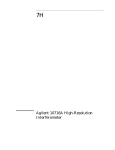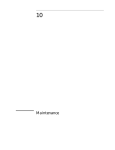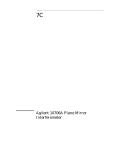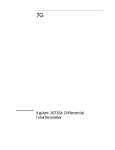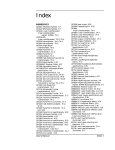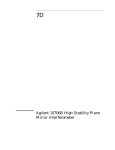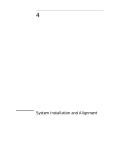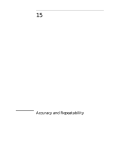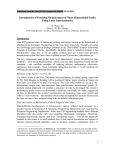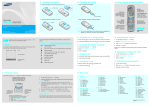Download Agilent 10735A, 10736A, and 10736A-001 Three
Transcript
7N Agilent 10735A, 10736A, and 10736A-001 Three-Axis Interferometers Chapter 7N Agilent 10735A, 10736A, and 10736A-001 Three-Axis Interferometers Description Description The Agilent 10735A and Agilent 10736A Three-Axis interferometers (see figures 7N-1 and 7N-2, respectively) provide three parallel interferometers in a single housing. They allow up to three measurements (displacement, pitch, yaw) to be made on a single axis. The Agilent 10735A and Agilent 10736A interferometers are identical except for their measurement beam patterns. The Agilent 10736A-001 interferometer (see Figure 7N-3) is identical to the Agilent 10736A interferometer, except that its Measurement Axis #2 beam paths are bent at right angles away from its other measurement axis paths. These interferometers are designed to use a 9 mm diameter laser beam, available from an Agilent 5517C-009 Laser Head. Smaller-diameter laser beams can be used, but the usable angle range is reduced. Agilent 10725A 50% Beam Splitters and Agilent 10726A Beam Benders are available for use in delivering the beam from the laser head to the interferometer. Agilent 10780F, E1708A, or E1709A remote receivers are used at the Agilent 10735A’s laser output apertures. The measurement beam parallelism inherent in the design of the Agilent 10735A and Agilent 10736A interferometers ensures that there is essentially no cosine error between their three measurements and also ensures angle accuracy for pitch and yaw measurements. The Agilent 10736A-001 interferometer has the same parallelism characteristic for its two parallel measurement axes. These interferometers are designed for direct attachment of Agilent 10780F, E1708A, or E1709A remote receiver fiber-optic sensor heads (one per axis). This simplifies user assembly, since no optical alignment of the receiver is required. The three fiber-optic receiver sensor heads are attached directly to apertures on the same face of the interferometer as the input aperture. The optics of each of these interferometers are factory-aligned to predetermined mounting surfaces on the interferometer’s housing. This simplifies user installation and alignment of the interferometer in the measurement system. These interferometers are of the same type of high-stability plane mirror interferometer design as the Agilent 10706B interferometer. 7N-2 User’s Manual Chapter 7N Agilent 10735A, 10736A, and 10736A-001 Three-Axis Interferometers Description AGILENT 10735A THREE-AXIS INTERFEROMETER Int er fer is fer o 6A te me is x 3A er Int 73 r x 3A 10 To Measurement Mirror om 10 ete 73 r 5A See View B See View A Axis #3 Not Used Input for all Axes Axis #3 Output Do not loosen these (or any) screws Axis #1 Output Primary Beams Axis #2 Output Axis #1 View A INPUT FACE Axis #2 View B MEASUREMENT FACE Figure 7N-1. Agilent 10735A Three-Axis Interferometer User’s Manual 7N-3 Chapter 7N Agilent 10735A, 10736A, and 10736A-001 Three-Axis Interferometers Description AGILENT 10736A THREE-AXIS INTERFEROMETER 10 fe Int er 5A ete r xis 3A er fer To Measurement Mirror om 10 3A Int xis 73 m ro ete 73 r 6A See View B See View A Axis #3 Not Used Input for all Axes Do not loosen these (or any) screws Axis #3 Output Axis #1 Output Primary Beams Axis #2 Output Axis #1 View A INPUT FACE Axis #2 View B MEASUREMENT FACE Figure 7N-2. Agilent 10736A Three-Axis Interferometer 7N-4 User’s Manual Chapter 7N Agilent 10735A, 10736A, and 10736A-001 Three-Axis Interferometers Description AGILENT 10736A-001 THREE-AXIS INTERFEROMETER PRODUCT EQUIPPED WITH er fer er Int Int fer is o OPTION 001 5A te me is x 3A 73 r x 3A 10 To Measurement Mirror om 10 ete 73 r 6A See View B See View A Axis #3 Not Used Input for all Axes Do not loosen these (or any) screws Axis #3 Output Primary Beams Axis #2 Output Axis #1 Output Axis #1 View A INPUT FACE Axis #2 (Bent Axis) View B MEASUREMENT FACE Figure 7N-3. Agilent 10736A-001 Three-Axis Interferometer Applications General The Agilent 10735A or Agilent 10736A interferometer, by making three simultaneous distance measurements along or parallel to the X-axis, can make these measurements: • displacement along the X-axis • rotation (pitch) about the Y-axis • rotation (yaw) about the Z-axis Because it has only two parallel measurement axes, the Agilent 10736A-001 can make the displacement measurement and one angular measurement. User’s Manual 7N-5 Chapter 7N Agilent 10735A, 10736A, and 10736A-001 Three-Axis Interferometers Description MEASUREMENT USING AGILENT 10735A AND AGILENT 10736A-001 INTERFEROMETERS Laser Head Beam Directing Optics Agilent g 10735A A Three-Axis Interferometer To Fiber Optics Receivers Agilent g 10736A-001 Three-Axis Interferometer To Plane Mirror (Auxiliary Measurement) Multiaxis Stage To Fiber Optics Receivers Figure 7N-4. Measuring Using Agilent 10735A and Agilent 10736A-001 Interferometers The angular measurements made by any of these interferometers can be calculated by taking the arctangent of the differences between two linear measurements involved, divided by their separation: Y – Y’ THETA = arc tan -------------D This method for determining angle is described in more detail under the “Electronic yaw calculation method” and “Optical yaw calculation method” subsections under the “Three-axis system using discrete plane mirror interferometers (X, Y, YAW)” section in Chapter 3, “System Design Considerations,” of this manual. X-Y stage These interferometers are well suited for X-Y stage or multiaxis applications, such as lithography equipment. One Agilent 10735A or Agilent 10736A interferometer, used with any other one of these three-axis interferometers, can measure all X, Y, pitch, roll, and yaw motions of a stage. In these applications, the measurement mirrors are attached to the X-Y stage. 7N-6 User’s Manual Chapter 7N Agilent 10735A, 10736A, and 10736A-001 Three-Axis Interferometers Description MEASUREMENT PATH (fB) Reference Mirror Agilent 10735A and Agilent 10736A Three-Axis Interferometers Axis #1 From Laser fB Axis #2 Axis #1 = f B±2 ∆f 1 Axis #2 = f B±2 ∆f 2 Axis #3 = f B±2 ∆f 3 Axis #3 λ/4 Plate NOTE: Because the Measurement mirror may have a combination of displacement, pitch, and yaw motions, the Measurement Axes may have different Df values, as shown Measurement Mirror REFERENCE PATH (fA) Reference Mirror Agilent 10735A, Agilent 10736A, and Agilent 10736A-001 Interferometers Axis #1 From Laser fA Axis #2 Axis #1 = f A Axis #2 = f A Axis #3 = f A Axis #3 λ/4 Plate Measurement Mirror COMPOSITE (f A) and (f B) Reference Mirror Agilent 10735A and Agilent 10736A Three-Axis Interferometers Axis #1 From Laser Axis #2 Axis #3 Axis #1 = fB±2 ∆ f1, fA Axis #2 = fB±2 ∆ f2, fA Axis #3 = fB±2 ∆ f3, fA λ/4 Plate Measurement Mirror LEGEND = fA = = fB = fA and f B Rounded corners are used to help you trace paths. Figure 7N-5A. Agilent Three-Axis interferometers — beam paths User’s Manual 7N-7 Chapter 7N Agilent 10735A, 10736A, and 10736A-001 Three-Axis Interferometers Description MEASUREMENT PATH (fB) Agilent 10736A-001 interferometer Reference Mirror Axis #1 f From B Laser Axis # 2 Axis #3 Axis #1 = fB±2 ∆f1 Axis # 2 = fB±2 ∆f2 Axis #3 = fB±2 ∆f3 λ/4 Plate NOTE: Because the Measurement mirror may have a combination of displacement, pitch, and yaw motions, the Measurement Axes may have different Df values, as shown Measurement Mirror Measurement Axis # 2 Measurement Mirror Measurements Axes #1 and #3 LEGEND = fA = = fB = fA and fB Rounded corners are used to help you trace paths. Figure 7N-5B. Agilent Three-Axis Interferometers — beam paths (continued) Optical Schematics Optical schematics for these interferometers are given in figures 7N-5A and 7N-5B. Each interferometer functions similarly to three parallel Agilent 10706B High Stability Plane Mirror Interferometers with a three-way beam splitter in front of them. To reduce thermal drift errors, the measurement and reference beam paths have the same optical path length in glass. This minimizes measurement errors due to temperature changes in the interferometer. 7N-8 User’s Manual Chapter 7N Agilent 10735A, 10736A, and 10736A-001 Three-Axis Interferometers Special Considerations Special Considerations Laser beam power consideration When working with an application that requires use of a separate beam splitter, make sure that you provide enough laser beam power to any multiaxis interferometer so all receivers connected to it receive adequate light power. This will help ensure that each measurement receiver in the system receives the optimum signal strength in the intended application. 9-mm laser beam considerations These interferometers are designed to use a 9-mm laser beam. The 9-mm beam is available from an Agilent 5517C-009 Laser Head. For more information about this laser head, see Chapter 5, “Laser Heads,” in this manual. Most Agilent beam-directing optics are designed for use with a 6-mm laser beam. For use in 9-mm installations, Agilent offers the Agilent 10725A Laser Beam Splitter and the Agilent 10726A Laser Beam Bender. These two optical devices do not include a housing or mounting hardware. For these optics, the user must devise mounts that will hold the required optics in position without causing stress that may distort the optic. The recommended receiver for the 9-mm beam is an Agilent 10780F Remote Receiver. The standard Agilent 10780C Receiver input aperture is designed for use with a 6-mm laser beam, so this receiver is not recommended for use in a 9-mm laser system. Using a 6-mm laser source allows use of standard Agilent 10700A, Agilent 10701A, and Agilent 10707A beam-directing optics, and use of Agilent 10710B Adjustable Mounts; however, this also reduces the usable angle range. Orientation Note that although illustrations may show the interferometer in one orientation, you may orient the unit as required by your measurement application — vertically, horizontally, or upside-down. User’s Manual 7N-9 Chapter 7N Agilent 10735A, 10736A, and 10736A-001 Three-Axis Interferometers Mounting Mounting General Before any of these interferometers are installed, a suitable mounting location must be prepared for it. These are “referenced” interferometers; this means that the relationships of their internal optical components and laser beam paths to reference locations on their bases are specified. These dimensions are presented in the “Specifications and Characteristics” section at the end of this subchapter and in Figure 7N-6. The specifications, plus the information in this subsection, are intended to allow you to select, design, and build a mounting location for a three-axis interferometer. The interferometer’s mounting location defines the relationship of its measurement beams to the stage whose motion is to be measured. Figure 7N-7 shows a recommended design for the interferometer’s mounting location. Kinematic mounting should be used. This means that the interferometer’s mounting location is completely defined by a plane, a line, and a point. The mounting plane is identified as datum A. It should be parallel to the plane of the X and Y axes of the stage being measured. 7N-10 User’s Manual Chapter 7N Agilent 10735A, 10736A, and 10736A-001 Three-Axis Interferometers Mounting AGILENT 10735A THREE-AXIS INTERFEROMETER Axis #3 MP3, Z-Axis See Notes 1 & 2 Not Used FROM LASER HEAD 21.0 (0.83) Axis # 1 Datum C 62.17 (2.45) Axis # 2 26.0 (1.02) 13.11 (0.52) Datum A MP1 See Note 1 See Note 3 26.22 (1.03) MP2 See Note 1 AGILENT 10736A THREE-AXIS INTERFEROMETER Axis #3 MP3, Z-Axis See Notes 1 & 2 FROM LASER HEAD 21.0 (0.83) Datum C 75.28 (2.96) Axis # 1 Axis # 2 Not Used 26.0 (1.02) 13.11 (0.52) Datum A MP1 See Note 1 See Note 3 26.22 (1.03) MP2 See Note 1 AGILENT 10736A-001 THREE-AXIS INTERFEROMETER Axis #3 MP3, Z-Axis See Notes 1 & 2 Datum C 75.28 (2.96) Not Used FROM LASER HEAD 21.0 (0.83) Axis # 1 26.0 (1.02) Datum A See Note 3 Axis # 2 (Bent Axis ) GENERAL NOTES: 1. For Each Axis: Darker Beam Indicates Primary Beam. Measurement Beams MP = Measurement Point 2. Suggested Position for Z-Axis Plane of Measurement is Axis #3 Measurement Point (MP3). MP1 See Note 1 3. Datum A (bottom of corner feet). 4. Drawing not to scale. Figure 7N-6. Three-Axis interferometers — beam patterns User’s Manual 7N-11 Chapter 7N Agilent 10735A, 10736A, and 10736A-001 Three-Axis Interferometers Mounting TO MEASURMENT MIRROR -C- 190 mm (7.48) 170 mm (6.69) 10.0 mm (0.39) 3 Pins X 4 mm Dia (0.16) Max Height < 5 mm (0.20) A A1 4.0 mm (0.16) 2.0 mm (0.08) Datum B A2 2X 8.0 mm (0.31) -B47.5 mm (1.87) 2.0 mm (0.08) 15.0 mm (0.59) 88.5 mm (3.48) 105.0 mm (4.13) FROM LASER HEAD 179 mm (7.04) 5.5 mm (0.22) 4X φ 6.0 mm Dia Thru (0.24) or 4X M5 Threaded Hole A 11.0 mm (0.43) A 11.0 mm (0.43) A3 A4 0.4 0.2 -A- SECTION A-A Figure 7N-7. Three-Axis interferometer — mounting The line of the interferometer’s mounting location is identified as datum B. It lies in datum A, and should be parallel to the surface of the stage mirror being measured. Physically, the datum B line is created by placing two dowel pins in the surface that forms the datum A plane. The point of the interferometer’s mounting location is identified as datum C. It establishes a specific installation location for the interferometer along the line of datum B. Physically, the datum C point is created by placing a single dowel pin in the surface that forms the plane of datum A. 7N-12 User’s Manual Chapter 7N Agilent 10735A, 10736A, and 10736A-001 Three-Axis Interferometers Mounting NOTE Although the general mounting arrangements for Agilent 10735A, Agilent 10736A, and Agilent 10736-001 interferometers are similar, they are not the same. The relation of their measurement beam patterns to the alignment point datum C are slightly different. An Agilent 10736A or Agilent 10736-001 interferometer installed in a mounting location designed for an Agilent 10735A interferometer (or vice-versa) may not give exactly the same results. One important consideration in determining interferometer placement is the relationship of the interferometer’s beam pattern to the coordinate origin of the system you want to measure. See Figure 7N-6. Looking at the interferometer’s measurement aperture face, the coordinate origin should be aligned with the (imaginary) vertical centerline of measurement axis #3. For an Agilent 10735A interferometer, this will also be the mid-point of a line joining measurement axis #1 and measurement axis #2. For an Agilent 10736A interferometer, this line will also be the vertical centerline of measurement axis #1. NOTE Datum C is at the end of the interferometer away from the interferometer’s input face. In the discussion below, your viewpoint of the interferometer is looking into its measurement face, with the interferometer’s mounting plate as the bottom surface. This is the view presented in the specifications dimension drawing at the end of this subchapter. For an Agilent 10735A interferometer, datum C should be 62.17 mm (2.448 inches) to the right of the origin, when looking into the interferometer’s measurement face. For an Agilent 10736A interferometer, datum C should be 75.28 mm (2.964 inches) to the right of the Z-axis, when looking into the interferometer’s measurement face. The (vertical) distance between datum A (the interferometer mounting plane) and the common centerline of measurement axes #1 and #2 is 26 mm (1.024 inches). With the interferometer installed in its predefined location, it is necessary to align the laser beam input to the interferometer. The input beam angle tolerance zone is defined as follows: When the interferometer’s measurement axis #1 primary beam is perpendicular to the measurement mirror and when the measurement mirror is perpendicular to datum A (the plane) and parallel to datum B (the line) of the mounting location (and, therefore, of the interferometer), the angular tolerance zone for the interferometer input beam is ±1 milliradian (mrad). User’s Manual 7N-13 Chapter 7N Agilent 10735A, 10736A, and 10736A-001 Three-Axis Interferometers Mounting This input beam tolerance zone, plus the tolerance to which the stage measurement mirror is perpendicular to datum A (the plane) and parallel to datum B (the line) determines the range of angular adjustment required of the beam benders directing the laser beam to the interferometer’s input aperture. 7N-14 User’s Manual Chapter 7N Agilent 10735A, 10736A, and 10736A-001 Three-Axis Interferometers Installation Installation Installation and alignment procedures for these interferometers do not involve adjusting or aligning the interferometer itself. Instead, the procedures adjust the beam coming into the interferometer. Pre-installation checklist In addition to reading chapters 2 through 4, and Chapter 15, “Accuracy and Repeatability,” complete the following items before installing a laser positioning system into any application. Complete Beam Path Loss Calculation (see “Calculation of signal loss” in Chapter 3, “System Design Considerations,” of this manual). Supply plane mirror reflectors. See Chapter 15, “Accuracy and Repeatability,” or “Specifications and Characteristics” section at the end of this subchapter for mirror specifications. Determine the direction sense for each axis, based on the orientation of the laser head, beam-directing optic, and interferometer. Enter the direction sense for each axis into the measurement system electronics. (See Chapter 5, “Laser Heads,” Chapter 14, “Principles of Operation,” and Chapter 15, “Accuracy and Repeatability,” in this manual. Supply suitable mounting means for all components of the laser measurement system, based on the recommendations given earlier in this subchapter and elsewhere in this manual. Provide for aligning the optics, laser head, and receiver(s) on the machine. (Ideally, you want to be able to translate beam in two directions and rotate beam in two directions for each interferometer input. This typically takes two adjustment optics with proper orientations.) Be sure to allow for transmitted beam offset of beam splitters (Agilent 10700A and Agilent 10701A) in your design. (See the offset specifications under the “Specifications and Characteristics” section at the end of this subchapter.) Allow for transmitted beam offset of beam splitters in your design. User’s Manual 7N-15 Chapter 7N Agilent 10735A, 10736A, and 10736A-001 Three-Axis Interferometers Alignment Procedure The positions of the interferometer’s measurement beams (its outputs to and inputs from the stage mirror) are referenced to datums A, B, and C, as shown in Figure 7N-7. Once the appropriately referenced mounting location is provided: a. place the interferometer against the mounting plane (datum A ), then b. push the interferometer against the pins that physically define datums B and C, and c. fasten the interferometer in position with four M5 mounting screws. Torque the mounting screws to 5 NM or 44 in-lbs while holding the interferometer firmly against the alignment pins, to keep it from moving. After the interferometer has been installed and secured into position, install the receiver(s) that will be used with it. Recommended receivers for use with these interferometers are Agilent 10780F Remote Receivers. Interferometer output apertures have alignment pins to ease the work of attaching the receiver sensor heads. Alignment The installation and alignment procedures do not involve adjusting or aligning the interferometer itself. Instead, the procedures adjust the beam coming into the interferometer. An Agilent 10735A, Agilent 10736A, or Agilent 10736A-001 interferometer has no user adjustments. Its optics are calibrated at the factory. You can treat it as a rigid pre-aligned optical bench. It is fastened in place against a referenced flat surface and against three reference pins to be supplied by the user in the measurement system. Adjustments required to align the system include positioning (translation, rotation, or both) of the laser head and of the beam-directing optics which deliver the laser beam to the interferometer input aperture. 7N-16 User’s Manual Chapter 7N Agilent 10735A, 10736A, and 10736A-001 Three-Axis Interferometers Alignment Laser beam alignment Objective The objective of the laser beam alignment procedure is to have the interferometer’s axis #1 measurement output beam perpendicular to the stage mirror when the mirror is in its zero-angle position (that is, perpendicular to the direction of stage travel). You can do this using autoreflection with the help of alignment aid (Agilent Part Number 10706-60001). The input beam should also be centered on the interferometer’s input aperture. Note that if the stage mirror is not perpendicular to the direction of stage travel, cosine errors can result. When interferometer axis #1 is correctly aligned, the other measurement axes will automatically be aligned because of the parallelism designed into the interferometer. Since the physical relationship of the interferometer and the stage (and its mirror) is fixed by the alignment pins at the interferometer’s mounting location, the only way to change the angle of the interferometer measurement output beams is to change the angle of the laser beam at its input aperture. The alignment procedure does not make any adjustment to or within the interferometer. Procedure The interferometer should not be moved during this procedure or afterward. Moving the interferometer will require that it be realigned. Movement of the laser head is allowed, assuming an adjustable mounting for the laser head is provided. Most of the alignment is performed by translating or rotating the optical devices that establish the laser path from the laser head to the interferometer. The goal of the alignment is to provide the four necessary degrees of adjustment of the input of each interferometer: • vertical and horizontal translation to center the input beam on the interferometer input aperture, and • pitch and yaw of the input beam to make the measurement beams perpendicular to the stage mirror. User’s Manual 7N-17 Chapter 7N Agilent 10735A, 10736A, and 10736A-001 Three-Axis Interferometers Alignment You should have handy: • a gage block or similar device you can use to autoreflect the beam back along its original path. • a piece of white paper or card stock you can use to check for the presence of the laser beam by making it visible to you. Initial angular alignment To achieve initial angular alignment of the input beam: a. Adjust the laser head turret to select the small beam output. b. Place a gage block over the interferometer’s input aperture. Hold the gage block in place by hand or with a rubber band. c. Adjust the angle of the input beam until the small beam from the laser head is autoreflected. d. Adjust the laser head turret to select the large beam output. e. Center the beam from the laser head on the interferometer’s input aperture by translating the input beam. f. Change back to the small beam aperture at the laser head. g. Place a magnetic alignment aid (Agilent Part Number 10706-60001) over the interferometer’s measurement axis #1 primary output aperture. (See Figure 7N-6, earlier in this subchapter.) h. Adjust the input beam angle such that the measurement axis #1 primary beam is autoreflected by the stage mirror. You may have to reduce ambient lighting in order to be able to see the laser beam autoreflection back at the laser head. You can do this by providing a temporary hood over the laser head output. i. Once the autoreflection described above has been achieved, change to the large aperture on the laser head and check to see that the input beam is centered on the interferometer’s input aperture. j. Lock down all beam benders, beam splitters, and the laser head. If finer alignment is required, continue the alignment procedure as described below. Otherwise, the procedure ends here and you can remove the alignment target. 7N-18 User’s Manual Chapter 7N Agilent 10735A, 10736A, and 10736A-001 Three-Axis Interferometers Alignment Finer alignment Perform the “Initial angular alignment” procedure above before you begin this procedure. a. Connect an Agilent 10780F Remote Receiver to the interferometer’s measurement axis #1 output aperture. b. Connect a fast-responding voltmeter (preferably an analog type) to the receiver’s test point. If necessary, adjust the interferometer’s input beam angle (via beam-bender or beam-splitter manipulation) until the voltmeter jumps to a value greater than 0.25 volt. This indicates that a signal has been detected. c. Continue adjusting the interferometer’s input beam to obtain a maximum voltage indication on the voltmeter. (The voltmeter reading may fluctuate.) d. Carefully adjust the interferometer’s input beam until the voltmeter indication suddenly drops back to about 0.3 volt. NOTE The alignment should be adjusted such that the voltage reading from the receiver test point occurs just below the sudden jump up in voltage. If the alignment is fixed to sustain this peaked voltage, system operation will be degraded. e. Remove the alignment aid from the interferometer. This completes the interferometer (input beam) alignment procedure. User’s Manual 7N-19 Chapter 7N Agilent 10735A, 10736A, and 10736A-001 Three-Axis Interferometers Operation Operation Measurements For an interferometer setup to measure distances along the X-axis, measurements of displacement, pitch, and yaw are derived as described below. These computations are done via software on the system controller or computer. Displacement For the Agilent 10735A interferometer, displacement along the X-axis can be measured as the average of the data returned from measurement axis #1 and measurement axis #2: measurement axis #1 + measurement axis #2 Displacement = --------------------------------------------------------------------------------------------------------------2 For the Agilent 10736A or Agilent 10736A-001 interferometer, displacement along the X-axis is simply the measurement axis #1 distance. Pitch For the Agilent 10735A interferometer, pitch (rotation about the Y axis) can be measured using data returned from all three measurement axes, and the vertical offset between the common centerline of measurement axes #1 and #2 and the centerline of measurement axis #3 (21.00 mm, or 0.827 inch): Displacement – measurement axis #3 Pitch = -------------------------------------------------------------------------------------------------- radian 21.00 mm or 0.827 inch For the Agilent 10736A or Agilent 10736A-001 interferometer, pitch (rotation about the Y axis) can be measured using data returned from measurement axis #1 and measurement axis #3, and the vertical offset between the centerline of measurement axis #1 and the centerline of measurement axis #3 (21.00 mm, or 0.827 inch): Displacement – measurement axis #3 Pitch = -------------------------------------------------------------------------------------------------- radian 21.00 mm or 0.827 inch 7N-20 User’s Manual Chapter 7N Agilent 10735A, 10736A, and 10736A-001 Three-Axis Interferometers Operation Yaw For the Agilent 10735A or Agilent 10736A interferometer, yaw (rotation about the Z-axis) can be measured as the difference between the data returned from measurement axis #1 and measurement axis #2, divided by the distance between them (26.22 mm, or 1.032 inches). measurement axis #1 – measurement axis #2 Yaw = ---------------------------------------------------------------------------------------------------------------------- radian 26.22 mm or 1.032 inch Because its measurement axis #2 is bent away from the path of its measurement axis #l and measurement axis #3, the Agilent 10736A-001 interferometer cannot make a yaw measurement. Error General A true “zero-deadpath” condition cannot be achieved with these interferometers, because of the interferometer’s design. For all measurement paths except the bent path of the Agilent 10736A-001 interferometer, zero-deadpath requires that the measurement reflector would have to be inside the interferometer, 6.59 mm (0.259 inch) behind the interferometer's measurement face. To determine the true deadpath distance: 1. Move the measurement optics to their measurement “zero” position. 2. Measure the distance between interferometer’s measurement face and measurement mirror. 3. Add 6.59 mm (0.259 inch) to the distance you measured in step 2. Use this distance for determining deadpath compensation. Agilent 10736A-001 Interferometer — Bent Axis For the Agilent 10736A-001 bent measurement axis (measurement axis #2), zero-deadpath would require that the measurement reflector be inside the interferometer, 34.42 mm (1.355 inches) behind the interferometer’s beam bender measurement face. To determine the true deadpath distance for this axis, use steps 1 and 2 the general procedure above, and then add 34.42 mm (1.355 inches) to the distance measured in step 2. User’s Manual 7N-21 Chapter 7N Agilent 10735A, 10736A, and 10736A-001 Three-Axis Interferometers Specifications and Characteristics Specifications and Characteristics Agilent 10735A Three-Axis Interferometer Specifications USE: Multiaxis applications such as precise positioning of multiaxis stages, where linear and angular control of the stage is required. The Agilent 10735A provides three linear measurements. Two angular measurements can be calculated from this data. When the interferometer is placed along the X-axis, yaw (theta Z), and pitch (theta Y) can be derived in addition to linear (X) displacement. When it is placed on the Y-axis, yaw (theta Z), and roll (theta X) can be derived in addition to linear (Y ) displacement. Redundant yaw is useful when mapping measurement mirrors, which provides improved accuracy. The interferometer can be made vacuum compatible. SPECIFICATIONS: Operating Temperature: 17 to 23°C Weight: 5.5 kg (12 lbs) Parallelism (Measurement beams): Axes 1 & 2: <40 µrad (8 arc-sec) Axes 1 & 3: <50 µrad (11 arc-sec). Optical Efficiency (output beam/total input beam): Average: 18% Worst Case: 10% INSTALLATION RECOMMENDATIONS Installation and alignment: Kinematic installation procedure requires three referenced pins mounted onto a referenced surface. Inter-axis Alignment: All internal optics are referenced to the mounting surface and have fixed alignment. Receivers: Agilent 10780F fiber-optic remote receivers. Dimensions: see Figure 7N-8 on the next page Receiver Alignment: Self-aligning when mounted to interferometer. MEASUREMENT AND REFERENCE (PLANE) MIRROR Materials Used: Housing: Invar and aluminum RECOMMENDATIONS Reflectance: 98% at 633 nm, normal incidence. Optics: Optical grade glass Adhesives: Vacuum grade Axis: 3 Linear axes which provide linear (X), pitch, and yaw; or linear (Y), Flatness: Depending on accuracy requirements of the application, mirror flatness may range from λ /4 to λ /20 (0.16 roll or yaw. to 0.03 µmeters, 6 to 1.2 µinches). Available Beam Size: 3, 6, or 9 mm Optical Surface Quality: 60—40 per Mil-0-13830 Thermal Drift Coefficient (Average): Axes 1 & 2: 40 nm (1.6 µin.)/°C Axis 3: 100 nm (3.9 µin.)/°C Resolution:* Optical: λ /4 Linear: 5 nm (using 32 × resolution extension) 0.62 nm (using 256 × resolution extension) Angular (pitch or roll): 0.7 µrad (0.14 arc-sec)-using X32 electronics 0.1 µrad (0.02 arc-sec)-using X256 electronics Yaw: 0.35 µrad (0.07 arc-sec, X32); 0.04 µrad (0.01 arc-sec, X256) Angular Range:** at distance = 150 mm at distance = 300 mm Pitch or roll + − 2 mrad (+ − 6.8 arc-min) + − 1 mrad (+ − 3.4 arc-min) Yaw (for 6 mm beam) + − 2 mrad (+ − 6.8 arc-min) + − 1 mrad (+ − 3.4 arc-min) Yaw (for 9 mm beam) + − 3 mrad (+ − 10.2 arc-min) + − 1.5 mrad (+ − 5.1 arc-min) 7N-22 NOTE: Flatness deviations will appear as measurement errors when the mirror is translated across the beam. Mount should be kinematic so as not to bend mirror. If accuracy requirements demand it, mirror flatness might be calibrated (scanned and stored in the system controller) to be used as a correction factor. *Linear and angular resolutions are dependent on the electronics used. Optical resolution is dependent only on the interferometer, and can be used to determine linear and angular resolutions when the electronic resolution extension is known. The linear and angular specifications in this section are for interferometer use with the X32 resolution extension electronics (10885A, 10895A) or X256 resolution extension electronics (10897B, 10898A). **Angular range for this specification is the maximum angle between the measurement mirror and the interferometer for a 6-axis system. Both angles (either pitch and yaw, or roll and yaw) can be at the angular limit concurrently. User’s Manual Chapter 7N Agilent 10735A, 10736A, and 10736A-001 Three-Axis Interferometers Specifications and Characteristics -C- 203.50 mm (8.01) 68.72 mm (2.70) 13.11 mm (0.52) 21.0 mm (0.82) 26.0 mm (1.02) 3 Axis Interferometer 3 Axis Interferometer 10735A -A- 190.0 mm (7.48) 63.96 mm (2.51) 44.3 mm (1.74) 18.80 mm (0.74) Laser Beam 2X 15.0 mm (0.59) 31.18 mm (1.22) 5.0 mm (0.19) 2X 8.0 mm (0.31) 11.2 mm (0.44) 4.0 mm (0.15) -B- -B7.0 mm (0.27) 105.0 mm (4.13) 47.0 mm (1.85) 60.0 mm (2.36) 26.0 mm (1.02) 31.25 mm (1.23) 2X 11.0 mm (0.43) 88.5 mm (3.48) 4×φ 5.8 mm Thru (0.228) 179 mm (7.04) 2X 11.0 mm (0.43) 5.5 mm (2.16) Bottom View Datum A This surface is recessed from Datum A by 0.5 mm (0.02). Figure 7N-8. Agilent 10735A Three-Axis Interferometer — dimensions User’s Manual 7N-23 Chapter 7N Agilent 10735A, 10736A, and 10736A-001 Three-Axis Interferometers Specifications and Characteristics Agilent 10736A Three-Axis Interferometer and Agilent 10736A-001 Three-axis Interferometer with Beam Bender Specifications USE: Multiaxis applications such as precise positioning of multiaxis stages, where linear and angular control of the stage is required. The Agilent 10736A provides three linear measurements. Two angular measurements can be calculated from this data. When the interferometer is placed along the X-axis, yaw (theta Z), and pitch (theta Y) can be derived in addition to linear (X) displacement. When it is placed on the Y-axis, yaw (theta Z), and roll (theta X) can be derived in addition to linear (Y ) displacement. Redundant yaw is useful when mapping measurement mirrors, which provides improved accuracy. The Agilent 10736A-001 provides a beam bender for one measurement path. When 10736A-001 is installed, yaw is not measured. The interferometer and beam bender can be made vacuum compatible. Parallelism (Measurement beams): Axes 1 & 2: <40 µrad (8 arc-sec) Axes 1 & 3: <50 µrad (11 arc-sec). Optical Efficiency (output beam/total input beam): Average: 18% Worst Case: 10% INSTALLATION RECOMMENDATIONS SPECIFICATIONS: Installation and alignment: Kinematic installation procedure requires three referenced pins mounted onto a referenced surface. Inter-axis Alignment: All internal optics are referenced to the mounting surface and have fixed alignment. Operating Temperature: 17 to 23°C Receivers: Agilent 10780F fiber-optic remote receivers. Weight: 5.5 kg (12 lbs) Receiver Alignment: Self-aligning when mounted to interferometer. MEASUREMENT AND REFERENCE (PLANE) MIRROR RECOMMENDATIONS Dimensions: see figures 7N-9 and 7N-10 on following pages Materials Used: Housing: Invar and aluminum Reflectance: 98% at 633 nm, normal incidence. Optics: Optical grade glass Flatness: Depending on accuracy requirements of the application, mirror flatness may range from λ /4 to λ /20 (0.16 Adhesives: Vacuum grade Axis: 3 Linear axes which provide linear (X), pitch, and yaw; or linear (Y), roll or yaw. to 0.03 µmeters, 6 to 1.2 µinches). Available Beam Size: 3, 6, or 9 mm NOTE: Flatness deviations will appear as measurement errors when the mirror is translated across the beam. Mount should be kinematic so as not to bend mirror. If accuracy requirements demand it, mirror flatness might be calibrated (scanned and stored in the system controller) to be used as a correction factor. Thermal Drift Coefficient (Average): Axes 1 & 2: 40 nm (1.6 µin.)/°C Axis 3: 100 nm (3.9 µin.)/°C Resolution:* Optical Surface Quality: 60—40 per Mil-0-13830 Optical: λ /4 *Linear and angular resolutions are dependent on the electronics used. Optical resolution is dependent only on the interferometer, and can be used to determine linear and angular Angular (pitch or roll): 0.7 µrad (0.14 arc-sec)-using X32 electronics resolutions when the electronic resolution extension is known. 0.1 µrad (0.02 arc-sec)-using X256 electronics The linear and angular specifications in this section are for Yaw: 0.35 µrad (0.07 arc-sec, X32); 0.04 µrad (0.01 arc-sec, X256) interferometer use with the X32 resolution extension electronics (10885A, 10895A) or X256 resolution extension electronics Angular Range:** (10897B, 10898A). at distance = at distance = 150 mm 300 mm **Angular range for this specification is the maximum angle + + Pitch or roll between the measurement mirror and the interferometer for a − 2 mrad − 1 mrad (+ (+ − 3.4 arc-min) − 6.8 arc-min) 6-axis system. Both angles (either pitch and yaw, or roll and yaw) can be at the angular limit concurrently. + + Yaw − 1 mrad − 2 mrad + ( 3.4 arc-min) + ( − 6.8 arc-min) (for 6 mm beam) − Linear: 5 nm (using 32 × resolution extension) 0.62 nm (using 256 × resolution extension) Yaw (for 9 mm beam) + − 3 mrad (+ − 10.2 arc-min) 7N-24 + − 1.5 mrad (+ − 5.1 arc-min) User’s Manual Chapter 7N Agilent 10735A, 10736A, and 10736A-001 Three-Axis Interferometers Specifications and Characteristics 203.50 mm (8.01) 13.11 mm (0.51) -C68.72 mm (2.70) 21.0 mm (0.82) 26.0 mm (1.02) 3 Axis Interferometer 3 Axis Interferometer 10736A 44.3 mm (1.74) 63.96 mm (2.51) 31.18 mm (1.22) -A- 190.0 mm (7.48) Laser Beam 5.0 mm (0.19) 2X 8.0 mm (0.31) 2X 15.0 mm (0.59) 11.2 mm (0.44) 4.0 mm (0.15) -B- -B- 7.0 mm (0.27) 105.0 mm (4.13) 47.0 mm (1.85) 26.0 mm (1.02) 31.25 mm (1.23) 2X 11.0 mm (0.43) 88.5 mm (3.48) 4×φ 5.8 mm Thru (0.228) 179 mm (7.04) 2X 11.0 mm (0.43) 5.5 mm (2.16) Bottom View 60.0 mm (2.36) -B- This surface is recessed from Datum A by 0.5 mm (0.02). Figure 7N-9. Agilent 10736A Three-Axis Interferometer — dimensions User’s Manual 7N-25 Chapter 7N Agilent 10735A, 10736A, and 10736A-001 Three-Axis Interferometers Specifications and Characteristics Datum C 203.50 mm (8.01) 13.11 mm (0.51) 68.72 mm (2.70) 21.0 mm (0.82) 26.0 mm (1.02) 3 Axis Interferometer 3 Axis Interferometer 10736A -A- 190.0 mm (7.48) 5.0 mm (0.19) 11.2 mm (0.44) 7.0 mm (0.27) 4.0 mm (0.15) 8.0 mm (0.31) 44.3 mm (1.74) 63.96 mm (2.51) 31.18 mm (1.22) 27.02 mm (1.06) 13.91 mm (0.54) -A- -B- 11.7 mm (0.46) 28.6 mm (1.12) 26.0 mm (1.02) 63.5 mm (2.50) 36.0 mm (1.41) Laser Beam 29.0 mm (1.14) 2X 15.0 mm (0.59) -B- 105.0 mm (4.13) 47.0 mm (1.85) 26.0 mm (1.02) 31.25 mm (1.23) 2X 11.0 mm (0.43) 88.5 mm (3.48) 4×φ 5.8 mm Thru (0.228) 179 mm (7.04) 2X 11.0 mm (0.43) 5.5 mm (2.16) Bottom View 60.0 mm (2.36) This surface is recessed from Datum A by 0.5 mm (0.02). -A- Figure 7N-10. Agilent 10736A Three-Axis Interferometer with Beam Bender—dimensions Product specifications and descriptions in this document subject to change without notice. Copyright (C) 2002 Agilent Technologies Printed in U.S.A. 07/02 This is a chapter from the manual titled: Laser and Optics User's Manual For complete manual, order: Paper version: p/n 05517-90045 CD version: p/n 05517-90063 This chapter is p/n 05517-90121 7N-26 User’s Manual



























